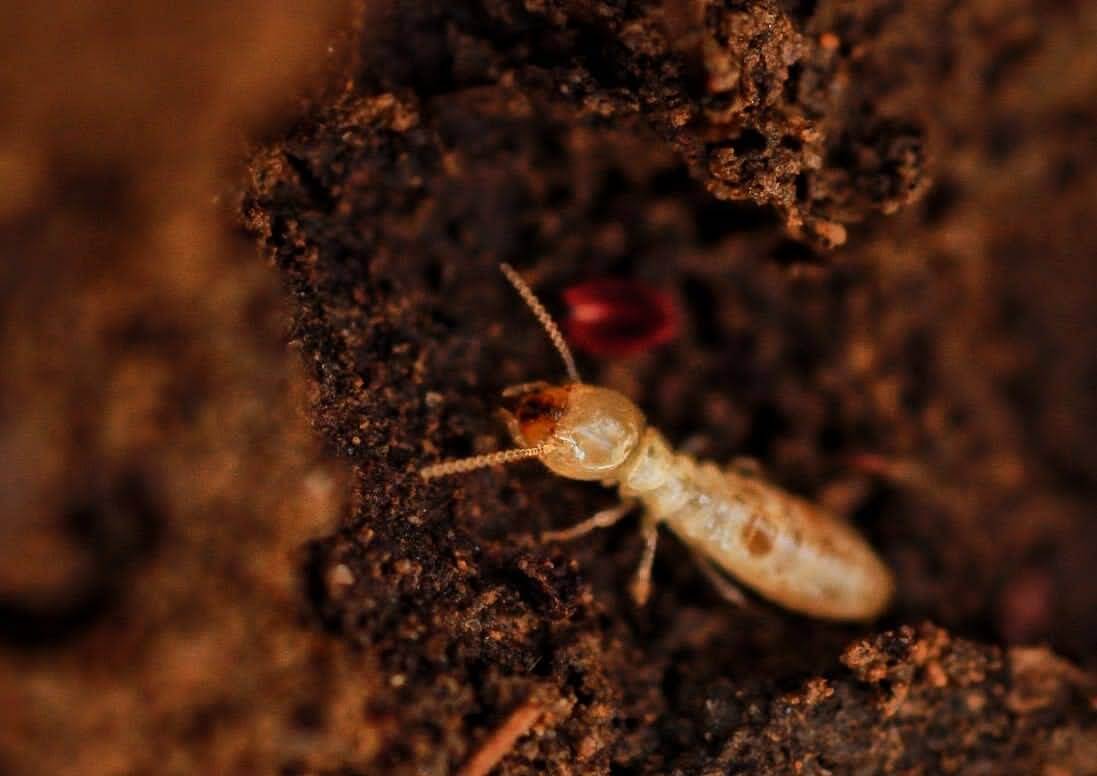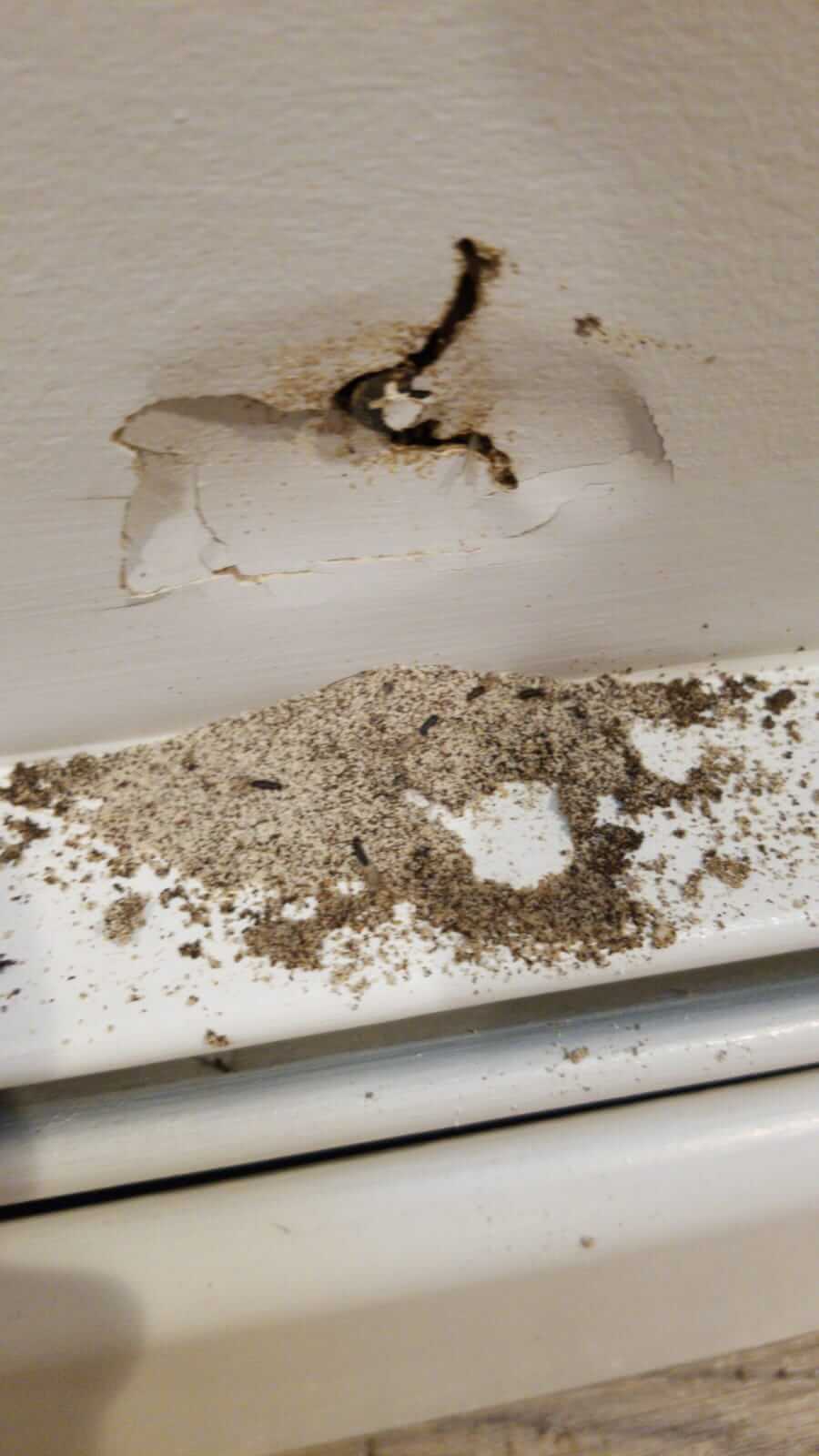Risks and Damages Caused By Termites
Structural Damage
Termites can significantly damage the structure of your home.
Financial Loss
Repairing termite damage can cost tens of thousands of dollars, impacting your valuable assets and potentially jeopardizing financial security.
Stress
Dealing with termite infestations is stressful, time-consuming, and disrupts your peace of mind.
Prevent small problems from turning into big headaches.
Schedule Service Now4 Easy Steps to Get Rid of Termites and Restore Your Home Enjoyment

1. Call
Our amazing, local customer service team is ready to help!

2. Schedule
Choose a convenient date and time.
3. Our Experts Get to Work
Custom solutions address and prevent issues tailored to your home’s needs.

4. Relax
Enjoy your pest-free home!
Brody Stats
40
Years in Business5
Offices in Maryland320+
Initial Training Hours Per Pest Control Expert2200+
Google ReviewsThe Most Common Termite Species in Maryland
Eastern Subterranean Termites

Swarmer Termites
- Appearance: Swarmer, or reproductive termites, are approximately ⅜ inches long.
- Why they enter: Construction flaws (such as the front steps going above the siding, siding starting where the wood members of the house begin, and mulch not kept 18 inches from crawl spaces and 6 inches from grade outside) and moisture sources are the most common reasons termites enter your home. They’re also drawn to fallen trees, stumps, and old roots.
- Unique fact: Swarmer termites are often mistaken for flying ants.
- Infestation size: Mature colonies typically range from 60,000 to 100,000 termites.

Worker Termites
- Appearance: Worker termites are approximately ⅛ inches long
- Why they enter: Construction flaws (such as the front steps going above the siding, siding starting where the wood members of the house begin, and mulch not kept 18 inches from crawl spaces and 6 inches from grade outside) and moisture sources are the most common reasons termites enter your home. They’re also drawn to fallen trees, stumps, and old roots.
- Unique fact: Termites can forage over the length of a football field.
- Infestation size: Mature colonies typically range from 60,000 to 100,000 termites.
Discover Why We're the #1 Trusted Exterminators in the Greater Baltimore Area
Selective Hiring
Our rigorous hiring process ensures that only the finest pest control experts join our team. Your comfort and trust are our utmost priority!
Extensive Training
We go above and beyond industry training standards to ensure our techs are true experts in family-friendly, effective termite control in Baltimore.

Family, Pet, and Environmentally-Focused Solutions
Our termite control treatments are highly effective and have been rigorously tested for human and environmental impact. Your family’s safety is our top priority.

A Team that Goes the Extra Mile
Our dedicated team of pest experts use the most advanced technology to tackle pest problems and proactively prevent future ones.

Impeccable Reputation
For 40 years, we’ve built a stellar reputation as the best exterminator for termites in Maryland. With 2200+ Google reviews and a 4.9-star rating, our commitment to customer satisfaction is unmatched!
What to Expect with Brody's Termite Control in Baltimore
Relax
No need to move anything before we arrive. Our experts will handle everything!
Inspect
We thoroughly inspect your home and yard for termite hotspots and potential activity areas.
Assess
We assess your home’s unique construction, location, and yard to evaluate the risk or extent of the infestation.
Treat
Targeted treatments eliminate the termite colony and prevent future pest problems.
Prevent
We strategically install Sentricon® bait stations around your home’s foundation to intercept and eliminate termite colonies before they can cause damage.
Follow-Up
Our experts follow up to ensure the infestation is eliminated and return for additional visits to prevent a new colony from reestablishing.
Ready to say goodbye to your termite problems? Schedule a free evaluation with us today.
Frequently Asked Questions about Termites
Termites can be hard to detect since they usually remain hidden until significant damage has occurred. Further, these infestations go unchecked when a homeowner mistakes termite swarmers for flying ants.
While they rarely emerge from their tunnels, there are several signs of termites in your home you can look out for to identify a potential infestation before it worsens:
- Swarming event – this usually happens in the spring after a warm rain
- Damage to floors or walls (often uncovered while performing a home renovation)
- Mud tubes made of soil and wood particles on garage or foundation walls
- Discarded wings
- Deteriorating or hollow wood
- Frass (termite droppings)
To learn more about the signs of termites, read 7 Ways to Detect Termites in Your Home.
Termite damage varies, depending on the type of termite and the extent of the infestation.
Here’s what damage often looks like:
- Small Pin Holes: Openings through which termites have eaten away the paper coating on drywall and wallpaper.
- Bubbling or Peeling Paint: This can indicate moisture from termite tunnels close to the surface, causing paint to bubble or peel.
- Dust Near the Wall Base: Dust that accumulates where the wall meets the floor, especially if it’s dark and resembles black pepper, could be a mixture of wall materials, wood debris, and termite droppings.
- Damaged Wood Trim: Wood trim and paneling in your home may show faint lines indicating termite tunnels. These lines, often running in various directions like a maze, signal termite activity.
By staying alert to these signs, you can catch a pest problem before it leads to extensive damage.

Termite swarmers are often mistaken for flying ants. Termites have straight waists, while ants have pinched waists. Additionally, termite swarmers shed their wings shortly after landing, which can be another helpful clue.
Termite removal can be much more complicated than treating other pests. The success of termite treatment depends on several factors, including the extent of the infestation, its specific location within your property, and the construction of your home.
Given the intricate nature of termite eradication, it’s crucial to hire pest control experts, like Brody Brothers. We use the most advanced pest control technology and extensive training to thoroughly target and destroy the colony.
Untreated termite infestations can cause significant, irreparable damage to your home.
Because they feed on wood, they gradually weaken the structural integrity of your house by damaging wooden beams, floors, and furniture. This damage can lead to sagging ceilings, cracked walls, and even structural collapse in extreme cases. Therefore, it’s essential to address termites promptly to prevent extensive damage to your property.
Getting rid of termites requires a comprehensive strategy, using the most advanced pest control products and interventions. Here’s a guide to understanding available extermination treatment options:
Soil Treatment with Termite Insecticides
Applying termite insecticides to the soil surrounding your home forms a protective barrier against termites. These chemicals help prevent termites from accessing your home, effectively reducing the chance of an infestation.
Direct Wood Treatment
When termites have infiltrated wooden structures, treating the affected wood directly with termiticides can eliminate these pests from within.
Termite Baits
Installing bait systems around the perimeter of your home can intercept foraging termites. These baits contain slow-acting poisons, or insect growth regulators, which they carry back to their colony, spreading the toxicant and gradually eliminating the colony.
Professional Termite Control Services
For an effective and long-lasting solution, contact professional pest control services. Our team of highly-trained expert exterminatorswill assess the extent of the infestation and implement a customized treatment plan for your home.
Call our pest control experts at (410) 653-2121and receive:
- A free total home inspection for termites and other common pests
- Installation of the Sentricon® Termite Colony Elimination System
- Regular monitoring for termite activity
- Continual maintenance on all Sentricon® Systems
Chemical Treatments
The chemicals fipronil and Noviflumuron are commonly used in termite extermination. Fipronil is a broad-use insecticide found in liquid termiticides. At the same time, Noviflumuron is used in baits (like the Sentricon® with Always Active™ system we use) to disrupt their growth and spread the toxicant throughout the colony.
At Brody Brothers Pest Control, we use Sentricon® with Always Active™ to protect Maryland homes from termite infestations. This system is the number one termite treatment system in the United States and is used in many high-profile buildings, including the White House!
The quickest and most effective way to eliminate termites is to call professional pest control experts like Brody Brothers. With over 40 years of pest control experience, we’re experts at eliminating termites in Maryland!
Each of our pest experts undergo 320+ hours of training, led by Levi Brody, an Associate Certified Entomologist with nearly 30 years of pest control experience, so they, too, become experts at getting rid of pests in your home. We have access to the highest-quality products that completely remove pests more swiftly and effectively than conventional DIY methods.
Many of our Maryland customers are delighted to learn that most of our professional products start working the day they’re installed.
When you first notice signs of termites in your home, it’s crucial to act promptly. Here’s a step-by-step guide:
- Contact a Termite Specialist: Our experts are equipped to handle termite issues effectively and implement measures to deter future pest problems.
- Do Not Disturb Them: It’s important not to interfere with them or attempt to eradicate them using standard household insecticides. Termites are adept at sensing disturbances and may relocate, making it harder for professionals to control and allowing them to continue causing damage in new areas of your home.
- Avoid DIY Remedies:If you’ve already tried a DIY termite solution, don’t worry but, instead, focus your energy on prevention. DIY and store-bought sprays repel termites so they avoid baits instead of sharing them with their colony and queen. Also, there’s no need to spray swarmers since 99% of them will die quickly without an environment with 100% humidity. You can simply vacuum those up.
Schedule a Professional Inspection: Contact a reputable pest control team, like Brody Brothers, to conduct a comprehensive termite evaluation on your property. Our specialists will assess your home’s interior and exterior, focusing on areas particularly susceptible to termite invasion.
When signs of termites emerge, it is best to contact a professional pest control company. Despite many online DIY solutions, they are typically ineffective at completely eradicating established termite colonies, leading to ongoing issues and increased property damage.
Instead, leverage professional pest exterminators’ expertise and specialized equipment to effectively eliminate termites from your home.
Proactive measures are crucial to protect your home against termites. Here are some steps Baltimore residents can take to prevent termites from entering your property:
- Keep wood-to-ground contact minimal: Maintain an 18-inch gap between the soil in crawlspaces or any other wooden structures outside, keep mulch dirt 6 inches away from the siding line of your home, and inspect your foundation regularly for any signs of termite activity or damage.
- Reduce Moisture: Termites thrive in moist environments, so reducing moisture around your home is crucial. Ensure proper drainage by installing well-functioning downspouts, gutters, and splash blocks to direct water away from your home’s foundation.
- Ventilation: Properly ventilate crawl spaces to reduce humidity levels, making them less favorable to termites.
- Landscape Maintenance: Trim vines, bushes, and hedges to prevent them from blocking vents, and avoid planting trees and shrubs too close to your home.
- Address Leaks Promptly: Termites require moisture to survive, so fix any leaks in plumbing or roofing promptly to avoid attracting them to your home.
- Clean Gutters and Pipes: Regularly clean out gutters and pipes to eliminate potential moisture spots for termites.
- Wood Management: Avoid stacking firewood against your house and remove tree stumps from your yard.
- Don’t Overapply Mulch: Mulch should be no more than 3 inches deep and remove old mulch before applying new.
- Schedule Regular Inspections: Nothing beats regular termite inspections! They are the #1 way to ensure that no new colonies have emerged and to catch infestations early before they cause significant damage.
Read 9 Ways Protect Your Home from Termites for more termite prevention tips.
Swarmer termites are the most visible and measure about 3/8 inch long (including wings). They’re dark brown to black, with grayish-brown wings extending beyond their bodies.
Worker termites are creamy white, approximately 1/8 inch long, and are rarely seen outside the mud tubes they create.
Termite activity in Maryland peaks from March to September, with ideal conditions in early spring when ground moisture is high and temperatures exceed 50 degrees.
Termites can forage over the length of a football field, so if your neighbor’s house has an active termite infestation, there’s a good chance they’re near your home, too.
Colonies can spread quickly, especially during swarming season, so scheduling a termite inspection is crucial if you believe you or your neighbors have termites.
Every year, numerous households in Maryland experience Eastern Subterranean termite infestations.
Unchecked termite activity can lead to significant structural damage in homes. Surprisingly, termites cause more damage to homes annually in the United States than all reported fires, tornadoes, hurricanes, and windstorms combined.
Termites primarily threaten wooden structures and are generally not harmful to humans; however, their presence can indirectly impact human health in several ways:
- Accidents:Severe termite infestations can weaken wooden structures, increasing the risk of accidents and injuries. Additionally, termites may chew on electrical cables, posing a risk of electrocution and damage to electronics.
- Stress: Dealing with a termite infestation can be stressful, given the risk of property damage, financial loss, and potential for recurring problems.
While termites may not directly harm humans, promptly eliminating them is essential to mitigate potential risks to property… and sanity.
Homeowners insurance usually doesn’t cover termite damage nor treatment costs, as they’re deemed preventable. Exceptions may exist, so review your policy and consult your provider to understand your coverage.
Regular inspections and preventative measures can safeguard your home from costly damage, even if not insurance-covered. If you suspect termite damage, contact a professional pest control company promptly. They can evaluate the situation, apply suitable treatments, and help prevent additional damage to your home.
Termite extermination typically costs between $499 and $1,500. Exact quotes depend on the type of termite, infestation level, size and location of your home, and treatment methods required, which are determined after an inspection.
Ask Our Expert Exterminators
- Termite Awareness Week: What to Know as Warm Weather Approaches
- 5 Signs of Termites in Your Home
- 7 Ways to Detect Termites in Your Home
- 9 Ways to Protect Your Home from Termites
- I Suspect I Have Termites – Now What Do I Do?
- Mice and Termites Make Themselves at Home in Homeland, MD
- Should You Be Worried About Termites?
- Stevenson: A Termite’s American Dream?
Your Comfort Is a Call Away
Our customer care team is local and ready to help with professional rodent removal! Call for a FREE quote and schedule your mouse pest control service today.
100% Satisfaction Guaranteed
As a Home Protection Plan customer, if you’re not satisfied with our pest control service, we will service your home at no additional cost until your issue is solved or receive your money back from your last scheduled service.


